One of the most crucial components of a healthy economy and quality of place is a sound transportation system: one that supports diverse modes of travel and seamlessly connects Rhode Island to the rest of the world – and Rhode Islanders, more meaningfully to each other and to opportunity.
Since I’m a big geek I watch videos like this and visit websites extolling the virtues of various transit systems around the world and I think to my self, ‘our system really sucks.’
Then I see a shiny video showcasing our system and I wonder if all those other cities just have really good videographers hiding the suckitude of their systems.
I think it is half and half; half our system sucks compared to others, and half other systems suck too but are good at publicity. Look at how the Interlink is described in that video, it sounds good, but it is not really there yet. There are a number of factors why, there’s really no there there at Warwick Station, it is not really a destination other than the airport (regardless of what this video is trying to sell us about the area). Rhode Islanders really still love their cars. There’s a chicken and egg about not enough riders so not enough service and not enough service so not enough riders, etc.
I say this all the time, RIDOT, especially Director Lewis, has been selling some really good commentary lately about our inability to build our way out of traffic congestion, our need for robust interconnected transportation options to drive a 21st century economy, you know, all the stuff I’m always going on about here. Then I sit in meetings and am told buy RIDOT staffers that even the most uncontroversial of transit planning innovations that are being rolled out routinely in other cities can never work here. And I see 12′ travel lanes in urban areas, and not enough timing on walk lights, and the inabality to even fathom accomodating bike lanes, etc. And I think, where does this gospel from the top get lost in implemenation?
Seriously, I’m asking. This video looks and sounds great, but how do we really get to that world where the car no longer automatically comes first and other innovations can happen, so long as they do not inconvenience the car? Because, I want to live in that world.
One more thing:
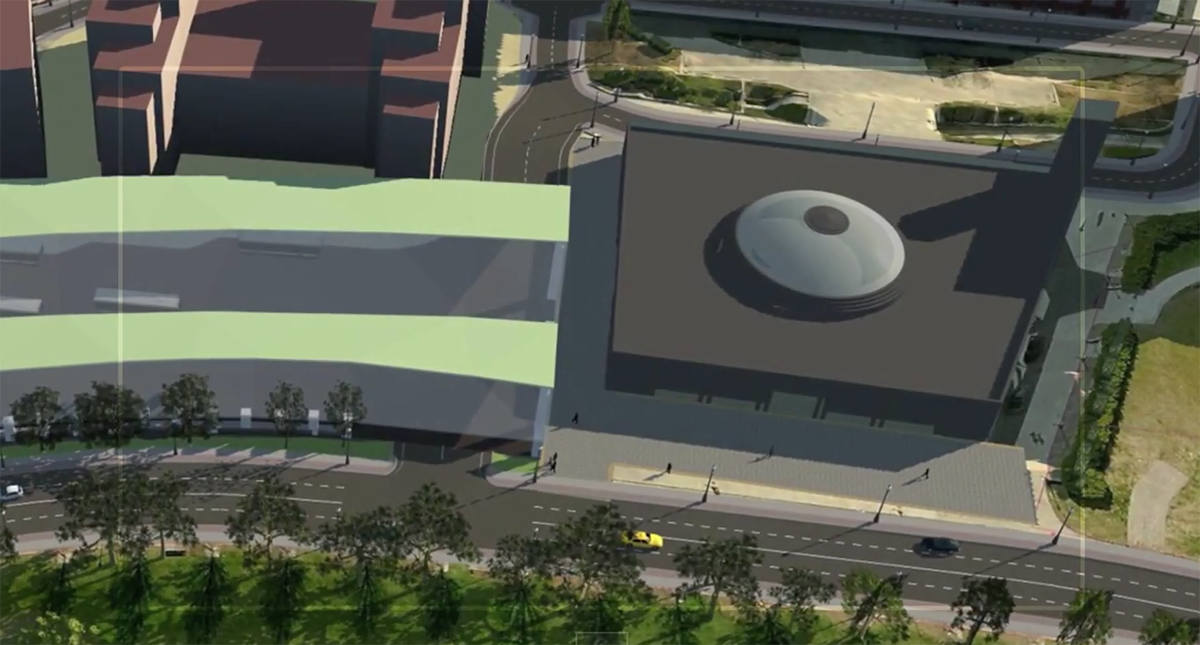
See how in this rendering Gaspee Street is marked as a 4-lane arterial? This is what I’m talking about, no, this is not actually a construction drawing, but it is a rendering that just automatically assumes a roadway needs to be 4-lanes. What is up with that?

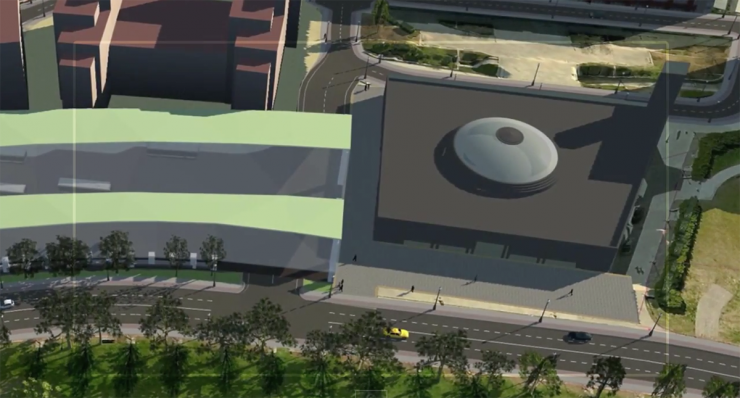
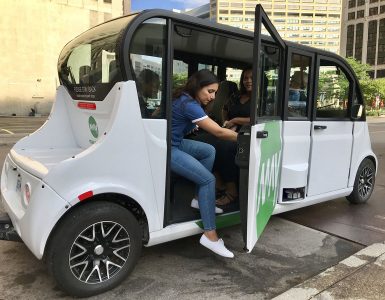
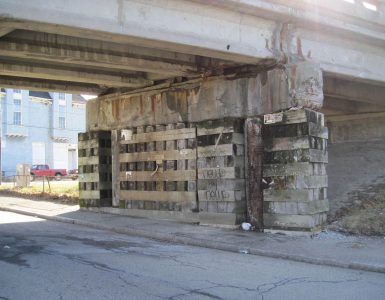
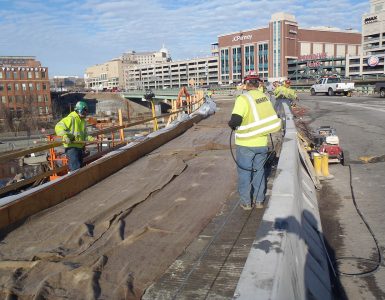

Move away from a property taxation model to an wage taxation model for municipalities. I think that one of the barriers to developing land to its highest and best use is the inevitable jump in property taxes once there is a building in place of a surface lot. This barrier could be reduced if a tax on wages/income results in a reduction in residential and commercial property tax rates. With more incentive to develop land comes higher density. Higher density will make it more practical for transportation via walking, biking, and transit. More practical transit use = more support = less emphasis on appeasing single occupant automobile usage = more diverse transport and connection options for people.
The rail amenities were engineered out of the Airport station in favor of parking that now sits empty. The experience for rail users reflects poorly on our understanding of what it means to integrate multiple modes of transit without preferencing the one we are attempting to get under control. Lets hope they can get it right at the train station. This is a big move and a long overdue one.
I think RIDOT just has a fetish for building roads, however, they can hardly even do that properly. No wonder the small “uncontroversial of transit planning innovations” can’t get done here – we can’t even build a road.
But, I’m totally with you and Director Lewis. Its like the president and congress; oil and water when it comes to actually getting anything done, and properly.
Terrible frame of reference…very parochial and state centric.
Three comments:
1) It is NOT Interlink-Warwick…it is Interlink-T.F. Green Airport.
Example of the political collusion between that mayor, the RIAC President, and Governor to minimize PVD
There is no “Warwick train station”…it is not a destination.
The Interlink was designed as a link from the airport to Providence
2) It is not TF Green Airport/Warwick..it is TF Green Airport/Providence
Another example of the political collusion between that mayor, the RIAC President, and Governor to minimize PVD
3) The mapping from Rhode Island to Boston and New York is demeaning – the connection is from PVD…and it is not even on the map!!!
An example of the lack of a metropolitan view and the significance of PVD at best, an effort to minimize PVD at worst
Until the leaders of the state realize that the entire state is the Providence Metro, they will not have a winning focus/frame of reference
Gosh—PVD needs a strong advocate.
All of these points are present everywhere, including places like NYC and Boston that have more emphasis on transit oriented development. The question is, what are solutions that may even out the transport modal balance in Providence?
Towne Street— shifting to wages is a terrible idea because that money is highly mobile and would crush jobs. Seriously.
The right solution to not wanting to tax improvments to underuitlized space is taxing land and not improvements. Tax the value of the space somethign is built on based on its highest, best use and not based on what’s there. That’s what creates the right incentives toward higher, better uses and requires folks to pay a lot for fallow undeveloped or underdeveloped land and it has none of the issues that going after wages does.
You don’t want to tax activities you encourage. The same problem with increased tax for increased investment into land applies to wages.
I feel like RIDOT is trying to increase transit ridership in a car oriented way. What I mean by is that they refuse to let go of their car mindset but yet are pro transit all the way. They are trying to improve transit on the wrong types of road designs and the wrong types of land usages which is not how you create world class transit. RIDOT can’t just say that you want to Rhode island to have world class transit when they aren’t designing roads that are pedestrian and bike friendly. I’ll have faith in RIDOT when they try to make most if not all of the state’s arterials pedestrian, bike, and transit friendly as well as aggressively promote transit oriented development/smart growth.
Double up on Jason’s thought. Philadelphia is one of the cities that has a wage tax, and it’s horribly regressive, kills jobs, and is one of these unpopular pieces of lore that hangs around the city like a brick around the neck. We should do a land tax, and especially focus initially on getting a parking tax.
Which brings me to. . . RIDOT! Can we please stop talking about park & ride solutions? Park & rides are not a good idea.
Thank you for the feedback. Again, I’m not trying to kill jobs and increase the tax burden. My point was simply to simply to find a progressive taxation solution to the high property tax burden that kills the incentive to improve land. I suppose my impression of income taxes are they are more progressive than property taxes.
Some thoughts on a land tax. Scale the tax rates based on infrastructure, services, and maximum development potential.
Downtown would have the highest rate(s), since it has extensive underground utilities, bus/train service, as well as the highest density zoning. The higher the permitted density of a zone the higher the rate (D1-300 would pay the most; D1-45 the least).
Commercial corridors and manufacturing zones would be next. Commercial corridors generally have strong transit service and permit 3- to 4- story structures that can cover most or the lot.
Manufacturing zones don’t always have the best transit options, but according to current zoning ordinance dense mid-rise development of 6- to 7- story buildings covering most of the lot is permitted.
The various residential zones could have lower rates based on density with single family zones being required to pay the least.
I believe that most Australian municipalities use a land-based tax system rather than a property-based tax. There may be other examples.
If a land based system were instituted, downtown surface parking lots would became instant hot potatos. Maybe the regressive car tax could be eliminated with the land tax as well.
The car tax is not regressive. It’s proportional to the value of one’s car & excludes people who don’t drive, who tend to be poorer.
The ‘regressive’ complaint is just about drivers trying to dress up their freebies as being something other than selfish.
How do you spot tax? Say, you have a high tax in the 300′ zone, but there are a lot of 5-8 story historic buildings you don’t want taxed into being torn down for bigger buildings. But also, there’s some eyesore one-story buildings built in the ’70s say, that you do want to pressure into being torn down. How do you say, this building needs to stay, let’s lower its tax, but this building sucks, let’s tax it higher? I’m thinking of the Jewelry District mostly I guess.
And in the Jewelry District, there’s some eyesore-ish one story buildings that actually contribute to the neighborhood character, I’m thinking lower Richmond Street. So you have the complication of viewing one building as contributing, but it’s twin down the block not contributing.
Touché
However the car tax is regressive in how it effects low income people much more than high income people.
I could be wrong, but including the car tax with a land tax proposal could help build consensus to make an actually change.
Also the car tax hasn’t done anything to reduce car usage or end the practice of constructing new surface parking lots.
There should be exceptions for historic, landmark, or culturally significant buildings. One of 300 zones is completely within historic districts. A land tax wouldn’t address the surface lots owned by non-profits.
The current system doesn’t work well or help the city government and residents. It’s worth considering or discussing a land tax—how it might work; how it’s been done in other parts of the world. If all of the city’s tax options were analyzed, perhaps a hybrid system (not the current system) could be developed.
Car culture remains dominant; the city’s buildings have for the last 50-years and continue today to be torn down to make way for surface parking. A new approach is needed. A land tax is one idea.
Poor people may not always have cars, but many of them need cars to get to the only jobs they can work because they can’t find jobs close enough to a bus route or the bus doesn’t run at times convenient enough for them to get to and from work without having to be there super extra early or wait super extra late to go home.
I’m not saying that cars should not be taxed, but the car tax in Providence is ridiculously high when the other options aren’t always feasible.
I like the idea of a parking tax necause it exempts green space, and puts the burden directly on lots themselves without complexity.
I’d be willing to trade away some car tax for a parking tax, but the real question remains whether a car is a public good. All things we buy and pay for are regressive in the narrow sense people are using it, but the loss of car tax revenue could make other things more expensive/ of lower quality that are more important to the public good than cars. A parking tax makes parking expensive, but we don’t object, because neither are as important as clean air or affordable housing.
It would help not to blame RIDOT r RIPTA that much, poor transit ridership is also a result of employers and shoppig centers giving “free” parking to all, overwhelming in Ralmost all of RI excpet downtown Providence which is why there is some real transit use there (same reason as that happens in much of Boston…) Unless that changes, there will be little effctive transit, national reserch shows that. But try changing that even at URI-Providcne!!
Second, it would also help not keep saying our transit system “sucks.” I have often found it is much better that most non-users think it is. If you live along bus routes such as 1 Hope-Eddy, #60 Newport and on the #21 Reservoir you will have about 48 buses each way each weekday, the 20 Elmwood, 56 Chalkstone and 31 Cransotn St both have about 64-68 such buses, the list can go on. I’ve found non-users, even some who should know better, guess much much lower. Of course, those who want to live in area with much less bus service won’t get that benefit, and employers rarely give it a thought and often locate in imposible areas tro have much transit use.
Third, transit activists will have to figure out how to proceed with the new reality in Washington, RI is unusally dependent on Federal support in transportation.
What Barry says is true. The people who show up to work at RIPTA every day do a fine job. With that, if where you need to go happens to be along your line and your line happens to be a busy one, then it does not suck, much. However.
The suckiness is…
A route system that is practically unchanged since streetcar days, over a lifetime ago. All transfers are downtown, and even that is about to become less convenient.
When people try the bus and feel that it spends more time stopped than rolling, they resolve that it is nicer to waste time in their own car than in the bus. To traffic congestion and stoplights add too many stops, plus waiting for people who like to prevent wear and tear on the back door, plus fumbles at the farebox, plus waiting to pull back into traffic after each stop. The R-line is a bit of progress (I can notice the improvement!) but still no exclusive lanes where most needed, no bus bulbs, and no off board fare collection. New “transit hub infrastructure” will not fix any of this suckiness. It is a matter of leadership.
Andrew, You could come with another word to articulate the less effective aspects of RIPTA’s system.
You raise valid points regarding the current hub and spoke system. Even though Providence is mostly a radial city, more could be done to create additional crosstown service and connections. In the past the streetcar passengers may have had more crosstown options than we have today. The 1918 Providence Atlas suggests that there were many more streetcar routes that crisscrossed the city than what is reflected today in RIPTA’s current bus system.
See: http://www.rootsweb.ancestry.com/~rigenweb/maps/1918prov/map-scans.html
The scanned maps are cumbersome to go though. The lines within streets with black dots indicate one streetcar track. Streets with two parallel dotted lines had routes in two directions.
Whether it was in the 1920s or 40s 150-milllion passenger trips per year is far more than today’s 26-million passenger trips by RIPTA bus riders. Even in the early 50s trolleybuses typically carried 100-million passengers per year.That kind of demand required much more equipment, personnel, and frequency of service.
It will take time to increase annual passenger trips. In the mean time incremental improvements can be made in the bus system. The R-Line is one. The proposed downtown hubs will be another.
The mass transit advocacy community can help by identifying problems and suggesting changes that are easy to adopt. Funding is always limited, so smaller improvements can have a reasonable impact. Multiple small improvements can add up. Keep in mind that the R-Line took several years to plan and cost $6-million to implement.
I think there’s a valid point to both the use and non-use of ‘suck’, but in defense of Jef, Andrew, etc’s use of it, sometimes to me it feels like there’s not a fire under people’s butts because there’s no acknowledgement of how lacking the sustem is. Certainly, I have heatd people from places like Kansas praise our system, but that’s only because some state’s really suck.
Put it this way: in Philadelphia, I read, combined bike/transit/walking is now up to 42%, making narrowly second best ahead of Chicago among large cities. But This Olde City put out a report saying “The only reason we’re second is because other US cities suck.” Providence needs to have limited, measured pride in what it does, but it also needs to hold itself to that kind of standard. We need to see how low the bar is, and not carried away resting on our laurels.
Also, sadly and frighteningly, we face a time sensitive climate crisis that’s on par with the nuke crisis of the Cold War. So we gotta’ push for more.
Improve the suckitude!
We live in America, New York City is the only system within reach of not sucking.
It has been a long time since any hint of a sex act associated itself in my mind with the usage of “Suck” in contexts like this. Nevertheless, the word’s power to grate is why people use it.
Crumminess? Lousiness? I don’t know but Suckiness seems to best convey how overall transportation design and policy embodies and reinforces assumptions about status. The most important person riding a bus is less important, their time less valuable, than the least important person traveling by car. This is the kind of thing that never changes unless people act up.
I hope with the passing of Question 6 it would also allow the Rhode Island Public Transit Authority to include other service to their operation such as an In State Commuter Rail & Water Transportation between Bristol, Warwick/TF Green Airport, Prudence & Hog Islands & Newport.
This was the last thread where land tax was discussed.
See link about Bridgeport and land tax:
http://www.ctpost.com/local/article/City-looking-at-hiking-taxes-on-vacant-properties-5957202.php